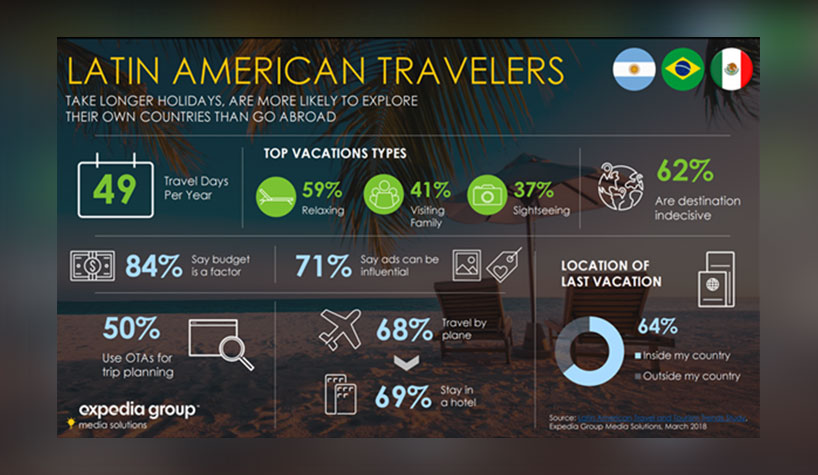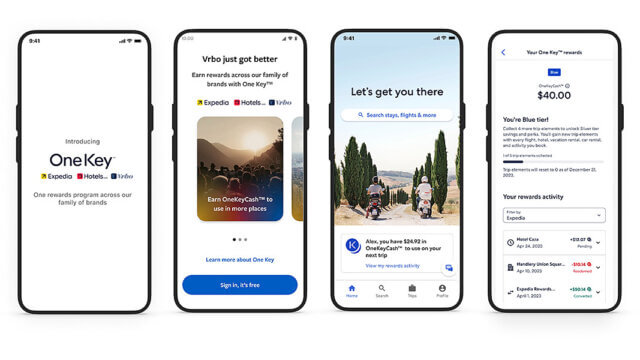ANAHEIM, CA—A new study commissioned by Expedia Group Media Solutions, the advertising arm of Expedia Group, reveals that Latin American travelers are mindful of their budget when planning a trip, but they prioritize trip activities and unique experiences over price. Sixty-four percent are taking trips within their own country, illustrating that Latin Americans are more likely to travel domestically than go abroad. The findings, from a survey conducted by Northstar Research Partners, spotlight the behaviors, preferences and influences of travelers from Argentina, Brazil and Mexico.
Released at the Destinations International Annual Convention, the Latin American Travel and Tourism Trends Studyshows that on average, Latin American travelers are taking nearly five trips per year, which is more than travelers from other countries, and the average leisure trip duration is 10 days. Despite their propensity for travel, six in 10 are undecided on a destination when they first decide to take a trip, and more than 70% are open to help and inspiration.
More than 50% of Latin American travelers use online travel agencies (OTAs) during the trip planning process, ahead of airline, hotel or destination websites. Forty-nine percent of travelers book their trip on an OTA—the strongest conversion from planning to booking among Latin American travelers. More than half use their smartphone when looking for travel inspiration and more than one-third conduct travel research on their mobile device. Unsurprisingly, mobile usage spikes in-trip, when more than 75% of Latin American travelers utilize their smartphone.
“Latin American travelers are taking more trips and longer trips than travelers from other countries, but interestingly, the majority opt to explore their own countries over traveling internationally,” said Jennifer Andre, senior director, North America and Latin America at Expedia Group Media Solutions. “Although Latin Americans may be more apt to travel domestically, they are often undecided on a destination, and they’re turning to a variety of sources for inspiration and information. This indicates a significant opportunity for marketers to reach and influence this audience throughout the path to purchase.”
How They Travel: Days, Ways and Stays
A deeper dive into the average number of trips per year reveals that Latin American travelers are taking nearly twice as many personal trips as business trips. Although Latin American travelers are more likely to explore their own countries than go abroad, 54% of Argentineans are taking international trips, and they’re often taking longer leisure trips—12 days on average. Argentineans and Brazilians (with an average trip duration of more than 11 days) are taking the longest trips, when compared to other countries around the world. Plane is the preferred mode of transportation for two-thirds of Latin American travelers, and 69% check into a hotel when they’re away from home.
Budget, Spend and Trip Types
Eight in 10 travelers said budget is a primary factor when researching and booking a trip, illustrating an opportunity for marketers to integrate deals, discounts and money-saving tips to reach Latin American travelers. Hotel, airfare and food accounted for more than 60% of the total travel budget, while shopping, attractions and transportation accounted for another 30%. Nearly 60% of Latin American travelers opt for relaxing trips, followed by visiting family and sightseeing trips.
Influences and Advertising
Most Latin American travelers are seeking help and inspiration when planning a trip, and they turn to a variety of sources to help inform their decisions. Eighty-two percent said informative content from destinations and travel brands can influence their decisions, 71% said ads can be influential and nearly 90% of travelers said they look for deals before making a decision. Relevant content and messaging are key to effective advertising; 60% of Latin American travelers said ads with appealing deals can be influential, and approximately half said ads with informative content or appealing images can influence their decisions.


